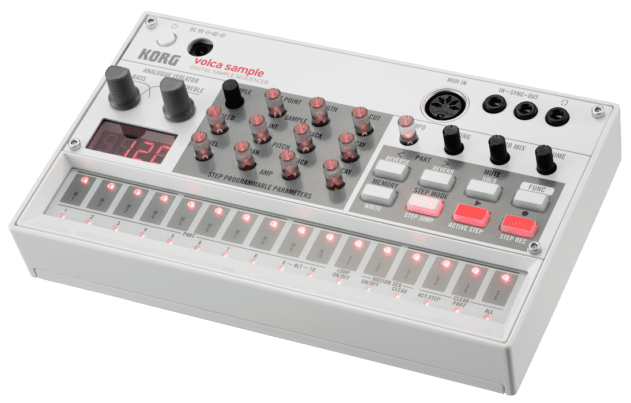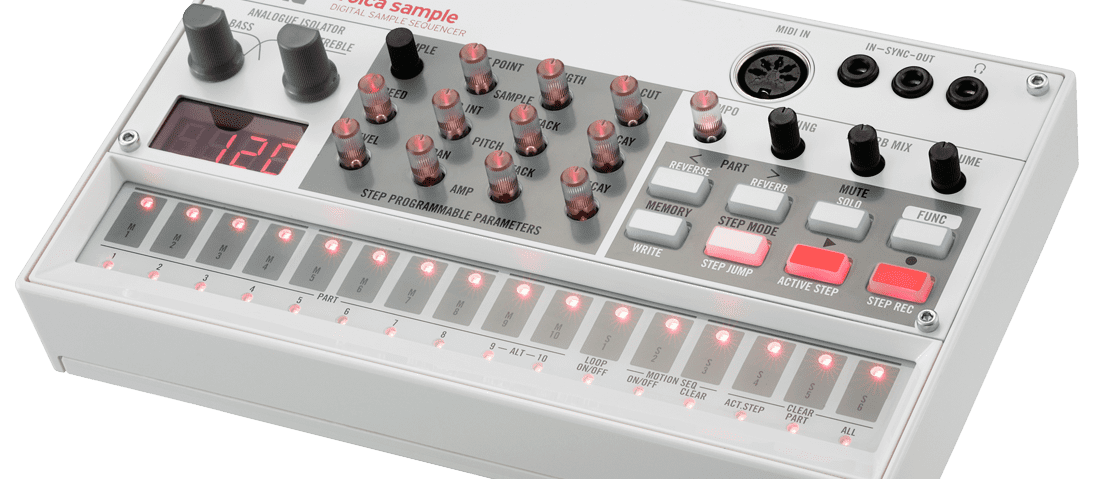Greg Scarth checks out the latest addition to Korg’s Volca range: a unique sample sequencer with its own character.

When Korg released the first three models in the Volca series in late 2013, they immediately generated a huge buzz. The reasons were obvious: they were affordable and they sounded great, but perhaps most importantly of all they were based around analogue technology. Until the announcement of the Volca Sample we’d assumed that the Volca series was defined to a large extent by its analogue circuits; the signal paths of the Bass and Keys are almost entirely analogue, while the Beats is around 75% analogue. The introduction of the Volca Sample changes that, with the two-band isolator filter circuit across the master output being the only analogue element. If the architecture of the Volca Sample is a break from the first three units, the rest of the design is much more familiar: it’s got exactly the same form factor and a very similar 16-step sequencer.
Before we take a closer look at the unit itself, let’s put the Volca Sample into context: this is one of the cheapest hardware samplers ever made. That’s not to say we should give it an easy ride based on its price – Korg have already proven they can deliver genuinely impressive instruments at this price point – but it’s important to get our expectations in line. At this price you shouldn’t expect a fully fledged sample sequencer like an MPC or an Octatrack.
Korg already makes a relatively affordable alternative in the shape of the recently announced Electribe Sampler. There are a number of similarities between the two units, but the Volca Sample is a much simpler affair. Just as the Volca Bass isn’t expected to compete with an MS-20 or the Volca Keys can’t match a MicroKorg, the Volca Sample isn’t meant to be as versatile or comprehensive as the Electribe.
this is one of the cheapest hardware samplers ever made
So what do you get for your money? Much of the formula is familiar from the other Volca units, particularly the Beats. The Volca Sample features ten sample slots, each of which can hold one of the 100 samples stored in the unit’s memory. The step sequencing features are, like the other Volcas, on the basic side but more than competent: in addition to the familiar options, the range of programmable parameters is much larger than the other Volca units and there’s a song mode for stringing sequences of loops together into arrangements.
The elephant in the room is that the Volca can’t actually sample from external signals (note that Korg describe it as a ‘digital sample sequencer’ rather than a sampler). However, that doesn’t mean you’re restricted to the built-in sounds. Custom samples can be uploaded to the unit via the Sync In socket using Korg’s own AudioPocket app and Korg have also released a software development kit for the Volca Sample, allowing third party developers to create software editors. I liked Single Cell Software’s Caustic Editor (available for Mac, Windows Android and iOS), which offers a good range of editing tools in addition to the basic sample transfer options. The inability to sample directly into the unit is by no means a deal-breaker for me; it’s a small sacrifice at this price point.
Given the lack of sampling options, there are obviously no A/D converters, preamps or analogue stages to colour the sound on the way in, but the relatively low sampling frequency (31.25 kHz, as opposed to the CD-standard 44.1 kHz) does give the Volca Sample a distinctive character during sample playback, particularly when you start to adjust the playback speed of samples. I found that a variation on the old sample-at-45-then-pitch-back-down trick worked well, pitching samples up slightly before transferring them to the unit, then pitching down to bring out the gritty character of the unit.
Given that the Volca responds so well to pitching sounds up and down, it’s disappointing that there’s no way to play samples chromatically along the keys (or via MIDI). Instead, you can only adjust the pitch using the Speed control. All 11 sample parameters (which include sample start points and length, basic pitch and amp options, plus a non-resonant low-pass filter) can be sequenced on a per-step basis, but trying to sequence melodies is a fiddly process compared to playing them chromatically. It probably puts the focus more on drums and individual hits rather than melodic elements, which feels a little bit like a missed opportunity.
The elephant in the room is that the Volca can’t actually sample
On the other hand, it’s certainly not a problem that advanced sample editing options such as auto chopping and granular looping are absent on a simple unit like this. A basic form of chopping can be achieved by assigning the same sample to multiple slots and adjusting the start point and length parameters accordingly, but it’s a slow and inaccurate process; if you want to chop samples you’re much better off doing it in software before uploading the individual slices to the Volca. The absence of a waveform display would make more advanced editing on the unit itself fiddly and frustrating, so it’s not missed.
There are a couple of areas where the Volca Sample sets itself apart from the other models in the range. It’s great to see the addition of a global swing control on the front panel, since the other Volca units can only swing when synced to an external clock signal such as Korg’s SyncKontrol app for iOS. The analogue isolator section is simple but effective, working across the entire stereo output and offering a useful real-time performance option (it can’t be sequenced or automated). The reverb option is an all-or-nothing effect that can be set on a part-by-part basis, with the only adjustable parameter being a single wet/dry mix control that affects all parts simultaneously.
The Volca Sample is a small departure from existing products in the Volca range, but it’s a hugely welcome addition to the line-up. There are very few hardware samplers left on the market, with just a handful of notable exceptions such as Akai’s MPC range, Elektron’s Octatrack and Korg’s own Electribe Sampler. Given that software such as Maschine or Ableton offers a more user-friendly and powerful approach to sampling than most hardware options, it makes sense for manufacturers to focus on creating hardware samplers with character rather than seeking hi-fi clarity and sonic perfection. The Volca Sample hits the mark at a very affordable price. Like the other products in the Volca range, it offers an excellent first step into the world of hardware or a useful addition to an existing production setup.
The Verdict
Price: £119
Purchase: Volca Sample
The Final Word
A welcome addition to the Volca range.

09.14 AM
A nice toy – i save my samples in Audacity as AMR 12,2 Bit and then save it back to WAV – that gives very small data and the raw sp 1200 sound.
06.13 PM
Curious: can it save/recall “kits” of various combinations of the 100 stored samples?
08.23 PM
Andre, you can save a kit as one of the 10 presets along with a sequence.
I love this little machine, my only problem is that I’ve used two of these that both have the same problem of unwanted hum. And in general I find the volca series can be a bit undesirably glitchy and noisy.
08.31 PM
Can the Sample really output its swing to other Volcas ?
02.49 PM
Thx, g! We’ve experienced noise w/ the other Volcas as well . . .
02.53 PM
just received this and mucked around with it for about 15 minutes. I have two other Volcas. You need to have the proper apps and conectivity to your Mac and iPhone/iPad to realize complete utility. The immediate editing capabilities seem to be more suited to performance than recording, but useful. There are some very thorough demo’s online -like the guy who uses a microwave as his sole sound source. I have a ton of old samples and old tracks that I plan on loading up. I’m not sure about full blown loops though. Seems more drum friendly.
Anyone expecting too much from basically a $100 machine, has never owned a real tactile sampler. Albeit, the Sample doesn’t sample directly !